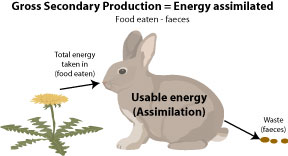2.5. 6: Primary and Secondary Productivity
 Organisms that use inorganic sources of energy, and particularly plants are the base unit of stored energy in any ecosystem. Light energy is converted to chemical energy by photosynthesis within the cells of plants
Organisms that use inorganic sources of energy, and particularly plants are the base unit of stored energy in any ecosystem. Light energy is converted to chemical energy by photosynthesis within the cells of plants
Because all the energy fixed by plants is converted to sugars it is in theory possible to calculate a plant’s energy uptake by measuring the amount of sugar produced. This is Gross Primary Production (GPP), because it occurs in the primary producers, an abstract that is difficult to measure. More useful is the measure of Net Primary Production (NPP).
An ecosystems NPP is the rate at which plants accumulate dry mass, usually measured in kg,m-2,yr-1, or as the energy value gained per unit time kJ,m-2,yr-1. This store of energy is potential food for consumers within the ecosystem.

NPP represents the difference between the rate at which plants photosynthesize (GPP) and the rate, which they respire (R). This is because the glucose produced in photosynthesis has two main fates. Some provides for growth, maintenance and reproduction with energy being lost as heat during processes such as respiration. The remainder is deposited in and around cells represents the stored dry mass (NPP=GPP-R).
The accumulation of dry mass is more usually termed biomass, and provides a useful measure of the production and use of resources.
Primary production is the foundation of all metabolic processes in an ecosystem, and the distribution of production has a key part in determining the structure of an ecosystem. Biological communities include more than just plants, they also include herbivores, carnivores and detritivores.
 Production also occurs in animals as Secondary Production. Importantly though animals do not use all the biomass they consume. Some passes through to become feces. Gross production in animals equals the amount of biomass or energy assimilated or biomass eaten less feces.
Production also occurs in animals as Secondary Production. Importantly though animals do not use all the biomass they consume. Some passes through to become feces. Gross production in animals equals the amount of biomass or energy assimilated or biomass eaten less feces.
As with plants some of the energy assimilated by animals is used to drive cellular processes via respiration the remainder is available to be laid down as new biomass. This is Net Secondary Production. Net secondary productivity (NSP ) = food eaten - faeces - respiration energy
so NSP = GSP- R (just like plants)
